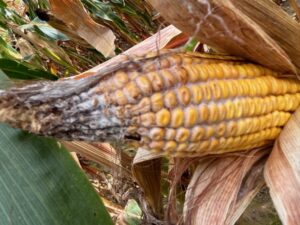Field Observations
SPRING 2024
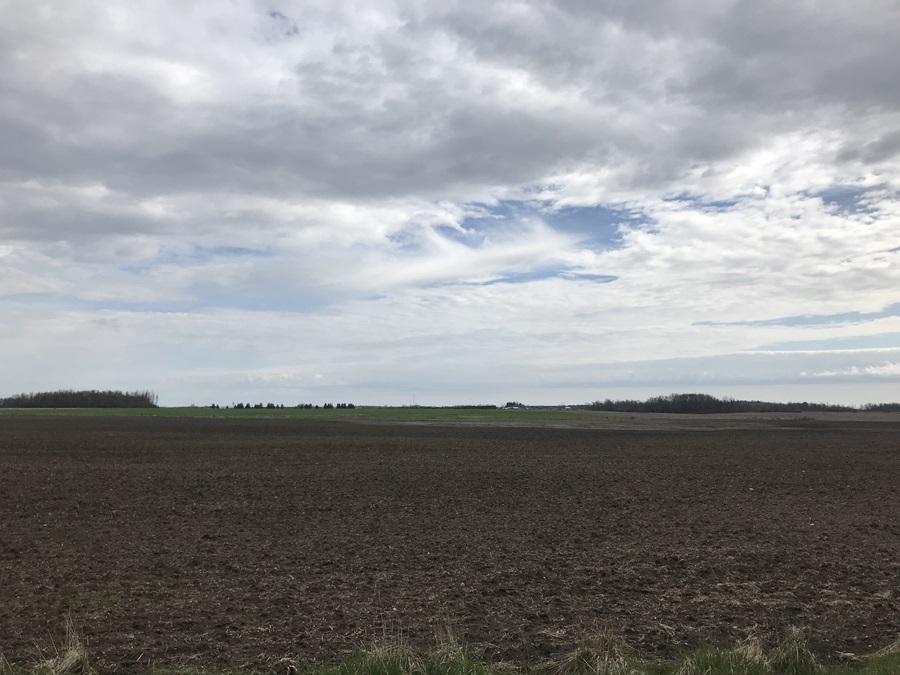
May 2, 2024
April showers bring May flowers – well, at this point of the year, there should be a good crop of flowers in the coming month. Rains have been variable across the province; however, there has still been enough rain to keep many farmers and their equipment parked. Winter wheat is still rapidly moving through growth stages depending on the region of the province. Warm weather and sunny skies in the future will see planters rolling.
Corn and soybeans
It is important to note that it is still early in the spring season. A few fields of corn have been planted where soil conditions have allowed. Once things dry up, there will be a push to get corn planted. There has been some groundwork in preparation for planting, and manure application has been the priority in livestock areas.
As conditions dry up, ensure that fieldwork and planting aren’t being “rushed.” Ensure that ground conditions are fit for planting. Seedbeds that are too wet when planting occurs can cause emergence issues, root growth issues and, in turn, yield losses.
A key thing to remember when planting corn is weed management. Corn can lose 1 to 3.5 bu per ac per day when weeds are present due to competition for resources and structural changes of the plant. Targeting weeds at emergence and when they are small using multiple modes of action are important keys to management.
Similarly, weed control is crucial for soybeans, especially with IP soybeans; do not let weeds get too large before controlling. Plan to start clean and stay clean, so that yield is not impacted by competition from weeds.
With warmer temperatures, insects are also becoming more active, in some cases much earlier than normal. Be on the lookout for true armyworm and black cutworm, wireworms, and bean leaf beetle (in southern Ontario, bean leaf beetle are out 2-3 weeks earlier than normal – if planting early, make sure the soybean seed is insecticide-treated, and be prepared to scout), and more. Good soil temperatures help plants emerge quickly, with less chance of insect feeding on seeds. The Pest Manager app is an excellent source of information on all pests. Grain Farmers of Ontario supports much of the research that is used in the app. It applies to pests, weeds, and diseases and is updated regularly based on current research data.
As planting ramps up, remember to stay safe.
Cereals

Some spring cereals have been planted, but wet conditions have limited current planting progress. As soon as ground conditions become fit, there will be a push to plant. Remember to check seed sizing and adjust the rate as needed.
Some winter wheat fields have received their second pass of N (or in some cases, a one pass for the year of N), along with a herbicide and T1 fungicide as required. It is incredible how advanced some fields are for this time of the year; it is anticipated that some early planted wheat fields (those planted in September in the southwest) will be creeping quickly towards GS 37 (flag leaf emergence), which means that early planted wheat in the warmer zones could be heading out in mid-May (in roughly two weeks).
Late planted wheat is staging where one might think is “normal” for this time of the year, roughly GS 31 (fist node).
Some winter wheat fields are seeing some winter annual weed pressure, with very advanced weeds in size and maturity. In these situations, fall weed control would have been a great option to keep the winter annuals under control.,.
Waterhemp
A very troublesome weed that many don’t realize has shown multiple forms of resistance across the province is waterhemp. This weed can germinate and emerge throughout the growing season and has high seed production. Waterhemp can be controlled By implementing a two-pass herbicide program using residual herbicides with multiple modes of effective action. Proper identification is key. Once identified, proper equipment cleaning before moving from contaminated fields is highly encouraged to reduce the spread.
Once harvest is complete, plant a cover crop. Cover crops will inhibit waterhemp emergence, growth and seed production. Grain Farmers of Ontario has created an Agronomy Alert on Waterhemp, which includes identification, locations of resistance and how-to programs for control of waterhemp.
More information on waterhemp biology, identification, and control.
Avian Influenza
The Avian Influenza (AI) virus can survive for extended periods of time in the environment, particularly in cooler weather. Here are some important reminders as shared by the Certified Crop Advisor Association. It is important to realize that tilling and planting equipment will cover fields that may have been contaminated by wild birds. Water, wet soil and feces can become contaminated with AI and linger after the migrating flock has moved on. Soil and wild bird feces can stick to tires and undercarriages of vehicles, including field equipment and all-terrain vehicles (ATVs), and be easily spread to other locations.
Follow these guidelines to help mitigate the risk of spreading the virus:
- Wash vehicles between livestock and poultry farms, paying close attention to the vehicle tires and wheel wells.
- For footwear, remove obvious mud and organic matter first and then scrub boots, especially the bottom tread, with a brush and hose. Ensure adequate contact time and concentrations for commercial disinfectants – be sure to read and follow the label!
- Clean all equipment used on the farm that could become contaminated.
- Planting and tilling equipment should be kept away from poultry and livestock barns and from driveways servicing poultry and livestock premises. Avoid contaminating ground areas near barns housing animals.
- Avoid driving near barns that contain animals if possible. If not, drive slowly to minimize dust.
- Avoid parking by exhaust fans and air inlets unless required as part of loading or unloading.
- If there is a visitor log book at the farm, sign it. If there is no log book, keep your own records identifying where you have been and when.
- Leave a note in a mailbox or parcel drop box to let the farm owner or manager know you were there.
- Before getting into your vehicle after a farm call, check to ensure your footwear is clean of organic material.
April 25, 2024
Many farmers are chomping at the bit and ready for spring planting, as April has been a cool, wet month. Fortunately, the long-range forecast does look promising, with warmer, dryer conditions that should see dust start to fly as planters hit the fields. The winter wheat crop is progressing well, especially with some warm weather.
Corn
As planting time approaches, the question comes up: when should planting actually begin? A key to establishing the crop’s potential is to plant it into a seedbed that can provide even and timely emergence. Most importantly, the soil needs to be fit (not too wet, not compacted, or lumpy) before planting for ideal emergence. The ideal soil temperature for planting corn is 10 °C to achieve uniform germination and reduce seedling stress, resulting in corkscrewing and leafing out under the surface. When placed in the soil, the seed will absorb about 30 percent of its weight in water, and the temperature does not affect water imbibition much. However, this differs from radicle (root) and coleoptile (shoot) growth; their growth is correlated with soil temperature. In cold soil conditions (below 10 °C), seeds will readily absorb water but not initiate root or shoot growth, leading to seed rots and poor emergence. Recommendations are to begin planting when soil is near 10 °C, or the forecast is favourable and trending warm. Some have experienced cold conditions after planting the last few years, and colder fields, like no-till fields, experienced lower populations due to cold stress, resulting in leafing out underground. Techniques to warm the soil or waiting until soils warm up will help establish better stand establishment with uniformity. Being aware of soil fitness and temperature helps ensure that plants will be off to a good start this spring.
The inaugural 2023 Ontario corn hybrid DON screening trial report provides a risk assessment of hybrids entered in the 2023 trials, along with a multi‐year assessment on the same hybrids if data were available. To learn how susceptible a hybrid may be, view the report at GoCrops.ca. Hybrids that have statistically higher DON compared to the susceptible check hybrid should be managed appropriately through the season. For more information on DON in general, view the Grain Farmers of Ontario DON in Corn Factsheet.
Soybeans
It is imperative to know soybean seed germination. As soybean planting edges closer and farmers are finalizing planting plans, something to consider is final plant stand goals and what planting population is needed to achieve that. Seed germination is one part of the calculation, as are planting conditions and weather after planting.
Due to poorer fall harvest conditions last fall, some soybean seed this spring may not be at the germination rate experienced in previous years. It would be wise to know the germination rate before planting so seeding rates can be adjusted. For example, if desiring a 150,000 plant stand, the planter will need to drop 187,500 if the germination rate is 80%. Also, adjust the rate based on seedbed conditions or if there are other concerns for emergence, like crusting, etc.
Seed tagged with Canada Certified No. 1 seed tag will have an 85% germination or greater. Canada Certified No. 2 seed will have 75% germination of greater. Note: some companies may have greater internal tolerances and this decides which seed lots to sell. Of course, everyone wants to sell the best quality, but conditions in the previous harvest may affect germination rates in different seed lots. A seed germination test is the best way of knowing, so asking about the germination rate of your seed provider or getting a test done before planting will provide you with the knowledge needed to adjust seeding rates.
Schedule 1 to the Seeds Regulations Grade Table 5 for Soybeans and Corn.
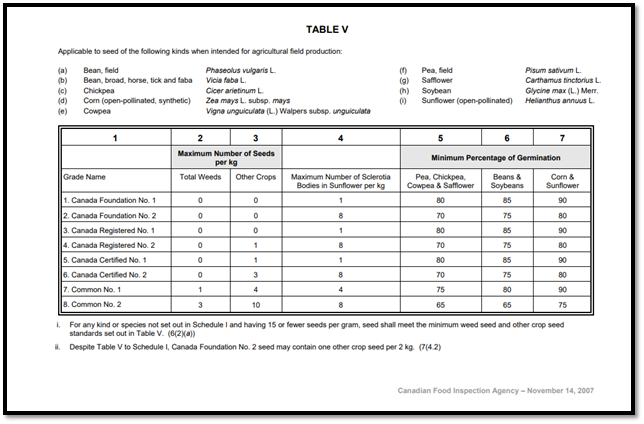
Winter wheat
Winter wheat is rapidly advancing with the warm weather, staging at GS 24 to GS 32, for some, wheat is at or near the second application of Nitrogen, along with a herbicide, a T1 fungicide, and if warranted a PGR (plant growth regulator). As wheat plants approach growth stage 30 (stem elongation) it is the last stage that some herbicides can be used without risk of injury.
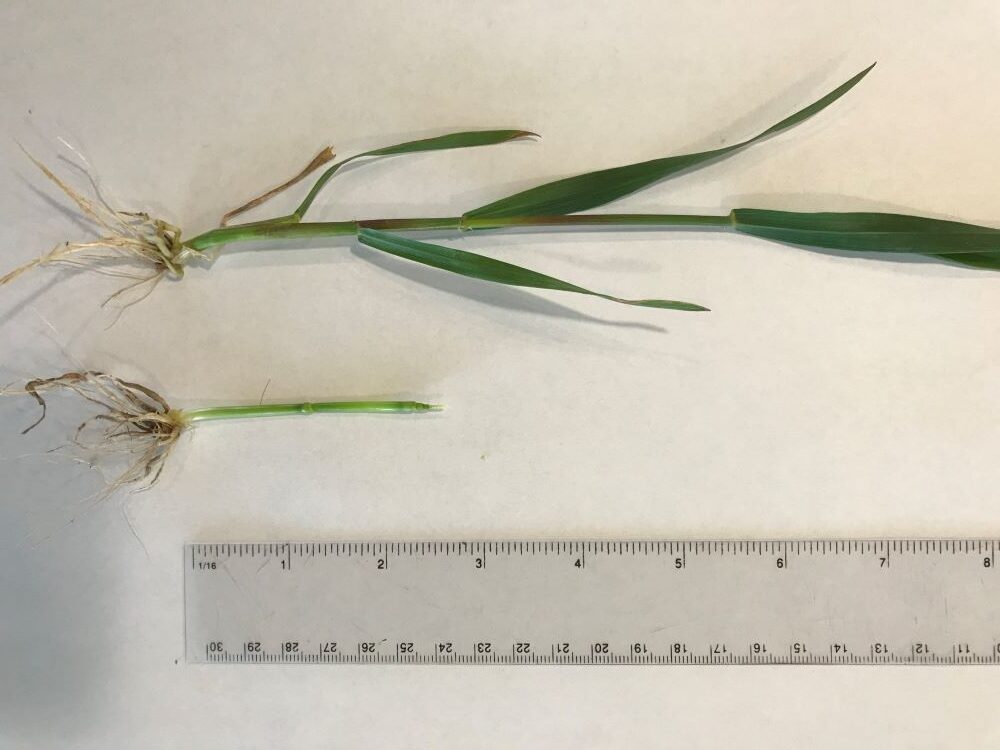
GS 31-37 can be very challenging stages to identify. Use a knife to split the main stem and count the number of nodes separated by the internode. GS 31 will have 1 node detectable, the first node detectable must be above an internode of at least 1 cm, while the second and so on nodes detectable must be above an internode of at least 2cm.
Weather in the past week, across most of the province, has not allowed spraying due to temperatures being too low, which could cause injury to the wheat crop. However, long-range temperatures look favourable. The challenge now will be to travel across the field without creating too much compaction on waterlogged soils.
April 18, 2024
Spring has sprung across the province, with wheat greening up and farmers readying planters and other equipment for a busy spring season. Last week, rains were seen across parts of the province, saturating fields, but with a few warm, sunny days, fields will start to dry up as we move closer to #plant24.
Wheat
Scouting to keep or terminate a wheat field has been ongoing in various areas. Some fields are looking quite good, others are struggling. This Field Crop News article gives a quick lesson on assessing wheat stands.
Fields across the province are staging between growth stage (GS) 24 (4 tillers) to GS 31 (stem elongation), depending on planting dates and crop conditions. There has been some talk of early nitrogen being applied on winter wheat as soils warmed and dried up. For those late-planted fields that need some help tillering this spring, putting a first application of nitrogen on early, at green up, will help plants tiller and improve yield potential. There have been questions on the amount of nitrogen lost through denitrification due to past rains occurring and future rains to come; there are a lot of variables at play with this question: soil type, nitrogen source, and amount of rain all come into play.
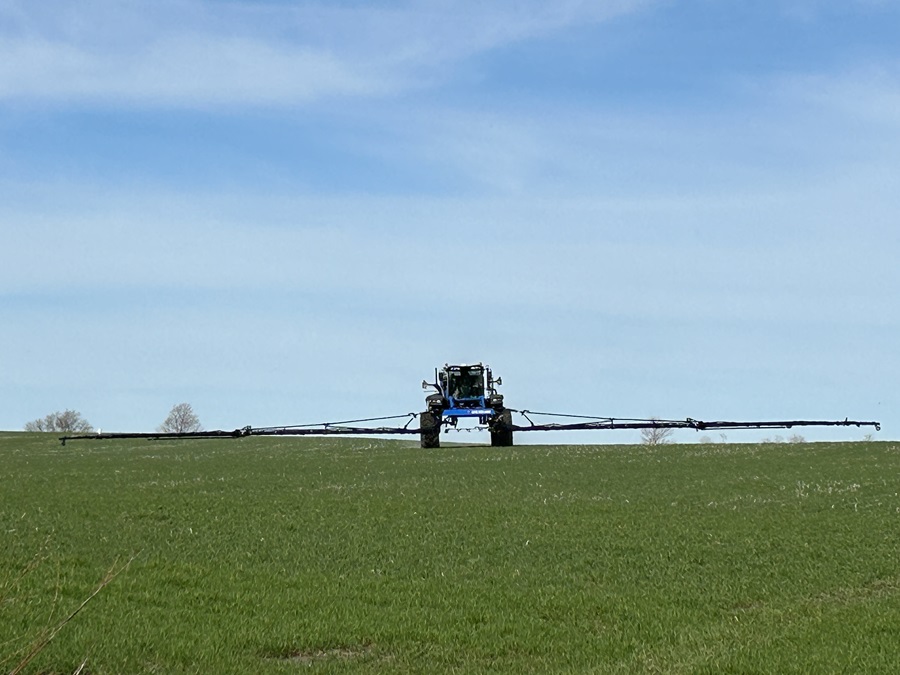
A later nitrogen application will be needed to help finish the crop. Fields that are further along in the growth stage will be looking towards herbicide, fungicide and potentially plant growth regulator timing. Be sure to pay close attention to temperatures; avoid temperatures below 5 °C the day before and after spraying for herbicide applications.
Fields planted early last fall tillered nicely before winter and are well established this spring. However, many fields were planted later than many would have liked. It is important to walk fields to check the growth stage of the crop. As scouting occurs, keep an eye out also for powdery mildew, as it thrives in mild winters.
A delay in nitrogen application can result in the crop showing signs of deficiency. The yellowing of wheat due to a lack of nitrogen in the soil is a sign of crop stress. Early stress on the crop will cause fewer florets to develop, which means fewer kernels and a lower yield at harvest. Some of the yellowing this year in wheat might also be due to wet roots; if this is the case over tile runs will be greener than not over tile runs.
It is also important to note herbicide requirements that many need to occur before stem elongation to prevent plant and head development damage. Any stress just before and during stem elongation can cause damage to the developing head and reduce the yield potential. Scout early and scout often for plant growth, weeds, and diseases.
Following the wheat crop along and timing crop protection and nutrient applications is important for optimizing yield. A Visual Guide to Winter Wheat Staging is a handy tool for identifying the growth stage of your crop!
Insects
As planting approaches, insect pests should be monitored as they may affect crop stands. In some cases, insect larvae can cause significant reductions in stands and early-season plant vigour. High-risk fields would be those that are being planted early, following hay or grass, fallow, or a grassy cover crop. Should the spring continue to be wet, it will be favourable to early-season pests. Learn more in this Field Crop News article, Cool wet spring favour early season pets.
Avian Influenza
Avian Influenza has been in the news as it travels across the U.S. As migratory birds travel into Ontario, it is important to keep biosecurity in mind when travelling from field to field. Ensuring you don’t step in bird droppings and staying away from poultry barns is critical, and thoroughly cleaning your boots and field implements when moving from field to field is always good practice. Field Crop News has some practical tips for biosecurity when moving machinery and walking fields.









